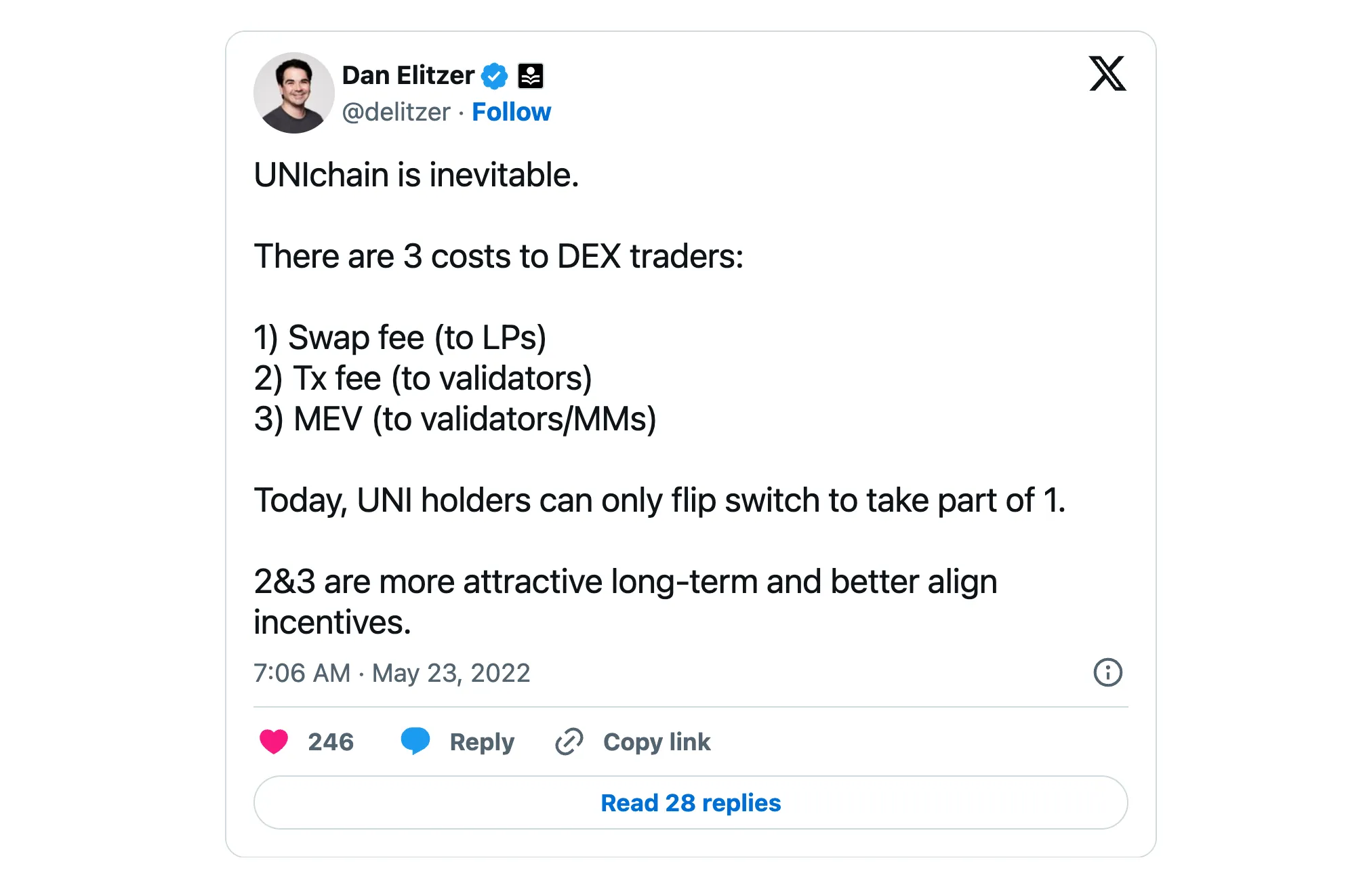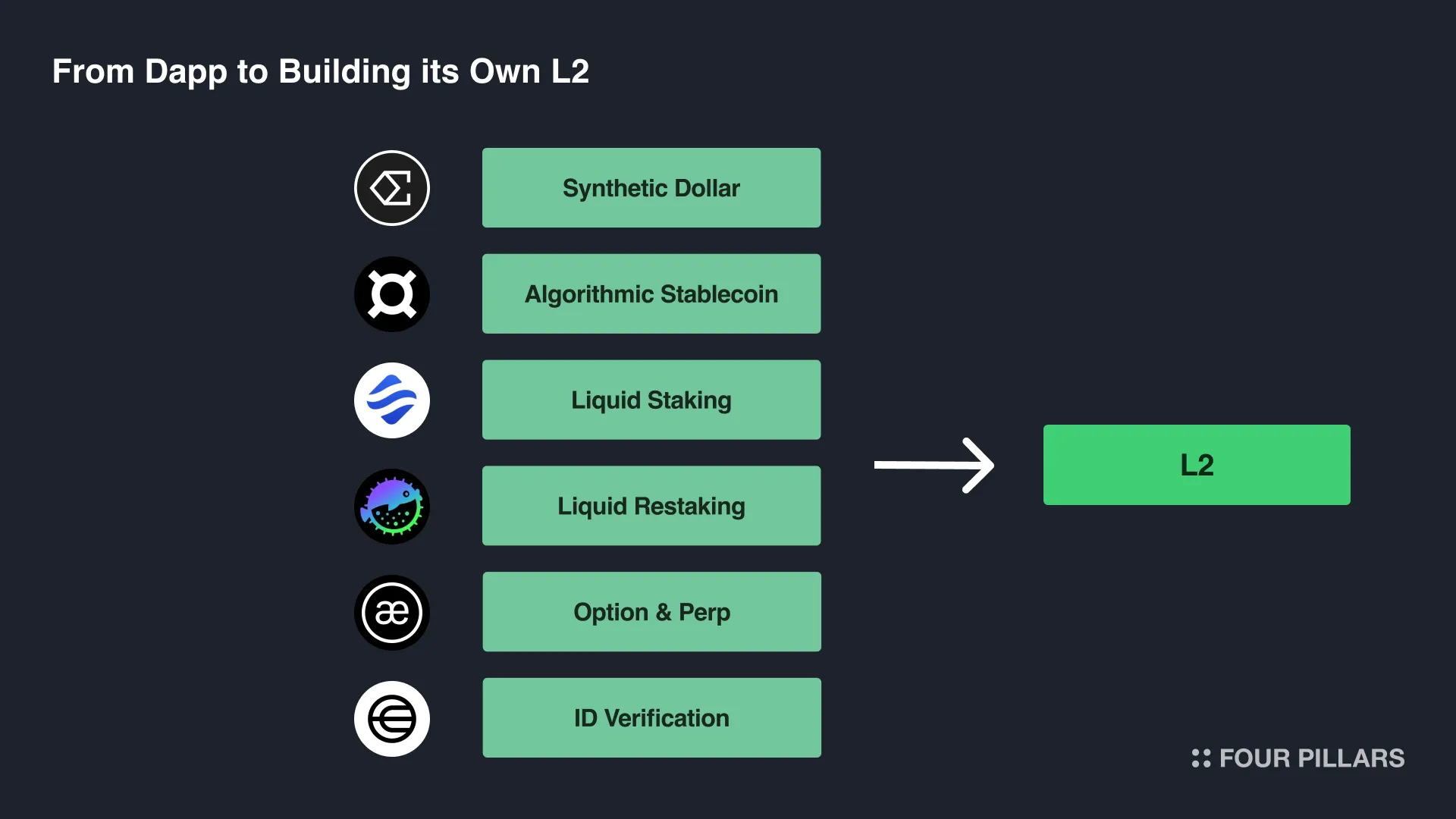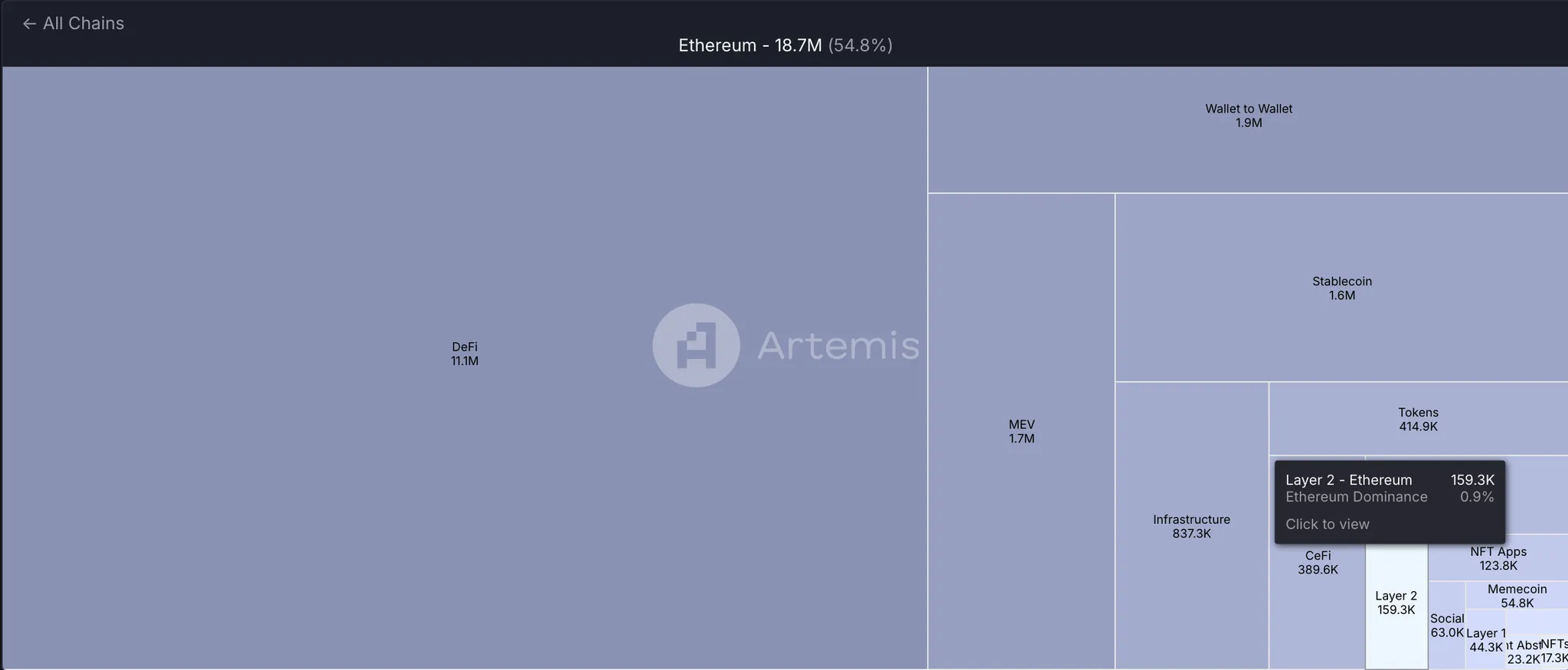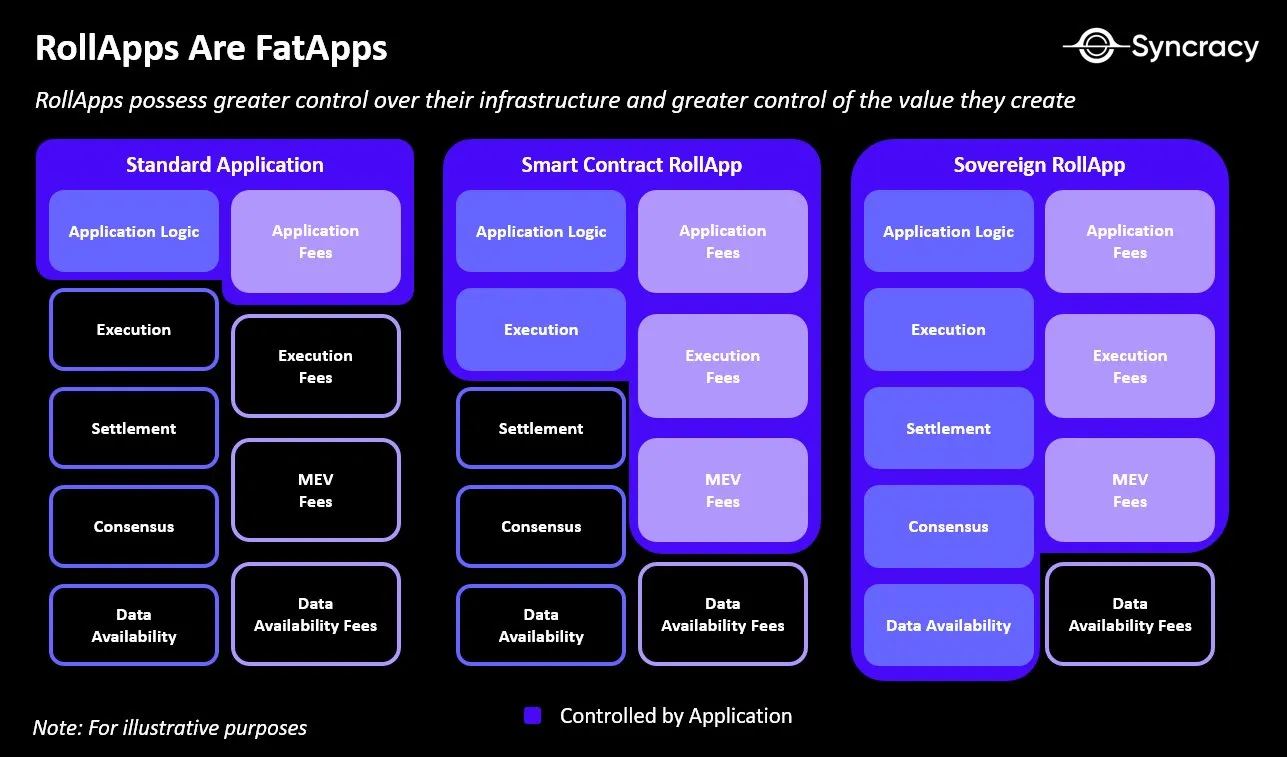In 2022, Dan Elitzer wrote about that Unichain is inevitable, arguing it would arise from inefficiencies and value leakage in the existing Uniswap system. He pointed out that Uniswap traders currently face three costs: swap fees paid to liquidity providers, transaction fees paid to Ethereum validators, and MEV costs.
This prediction has now become a reality with Uniswap, the most widely used DEX protocol in crypto, announcing its own Layer 2 called Unichain. This OP Stack-based rollup is designed to address key challenges in the DeFi ecosystem, focusing on improving transaction execution environments for DeFi, enhancing user experience, and solving liquidity fragmentation.

Source: X (@delitzer)
Dan's research revealed that transaction fees and MEV costs paid to Ethereum validators and market makers exceed the swap fees earned by liquidity providers. This implies that entities outside of Uniswap are in a superior position in terms of value capture, meaning that value that should go to Uniswap users, liquidity providers, or $UNI token holders is being extracted externally.
Summarizing his argument for the necessity of Unichain: Unichain can help reduce inefficiencies in value capture due to transaction fees and MEV costs, and increase the value for $UNI holders. Operating its own chain would allow Uniswap to significantly lower transaction fees, especially benefiting smaller trades. Moreover, solutions like threshold encryption or batch swaps could minimize MEV costs for traders.
The most significant advantage of Unichain would be better incentive alignment among Uniswap participants. Currently, $UNI token holders have limited value capture options, mainly restricted to governance decisions like adjusting swap fees. A dedicated chain would enable $UNI holders to benefit from transaction fees and internalized MEV, strengthening the token's value proposition. This approach could not only reward $UNI holders but also create a more efficient trading platform for users, potentially cementing Uniswap's position as the leading DEX.

Source: Uniswap, Flashbots, and OP-Stack: The Trinity Behind Unichain — 100y
Unichain is built with the OP Stack as a Superchain. It introduces two innovations to improve efficiency, user experience, and liquidity management across L2 blockchains.
The first key feature is Verifiable Block Building, developed in collaboration with Flashbots. This includes a mechanism called Flashblocks, which enables effective block times of 200-250ms by splitting each block into four sub-blocks. This system allows Unichain to achieve faster state updates. Additionally, Unichain uses a Trusted Execution Environment (TEE) to separate sequencers and block builders, and implements Priority Ordering to tax MEV opportunities, allowing applications to directly extract and internalize MEV.
The second major feature is the Unichain Validation Network (UVN), a decentralized network of node operators that independently validate the blockchain state. UVN allows Unichain to provide fast finality and settle cross-chain transactions through economic security. When a new block is created on Unichain, validators must attest to the canonical chain, which mitigates security risks associated with a single sequencer. To participate as a validator, one must stake $UNI, and if selected as part of the active node set based on stake weight, they execute validations and receive rewards accordingly. This operational model allows $UNI holders to delegate their stake to validator nodes and receive distributed rewards.
DeFi is no longer remaining as a single application but is choosing a development path that is becoming increasingly complex. DeFi applications are actively internalizing the value they generate, operating their own app chains or L2s, and developing wallet services. Application-Specific Sequencing (ASS), which allows applications to directly extract MEV, is also gaining attention. Among these trends, the launch of Unichain clearly reveals a future where DeFi with sufficient users and scale secures its own infrastructure.
DeFi is choosing to become more complex in its development process to internalize value that would otherwise be extracted externally, improve user experience, or provide self-contained money legos through the interoperability of its own financial products.
This trend manifests in applications that don't adopt L2 or L3 execution methods opting for ASS designs to prevent exposure to MEV extraction in the process of sequencing transactions. For instance, controlling the order of transactions dependent on external oracle data allows applications to directly capture MEV (Oracle Extractable Value, OEV) or prevent MEV exposure through intent-based batch auctions using solver networks. Alternatively, they are adopting methods to provide enhanced user experiences and prevent value leakage to external third-party infrastructure by developing auxiliary infrastructure such as wallet infrastructure or mobile interfaces optimized for the application.
2.1.1 ASS: CoW AMM
CoW AMM protects LPs from MEV by bundling transactions into a single off-chain Batch and auction arbitrage portions. In CoW AMM, solvers compete for the right to rebalance the CoW AMM pool whenever there's an arbitrage opportunity. The solver that provides the most favorable trading conditions for LPs and leaves the most profit (Surplus) in the liquidity pool gains the right to rebalance the pool. Through this batch auction, CoW AMM can capture the MEV value that arbitrage bots would extract while rebalancing price discrepancies in the liquidity pool, and eliminate the LVR (Loss Versus Rebalancing) risk from LPs.
2.1.2 Mobile / Wallet: Jupiter / Uniswap Wallet
Looking at the market share of devices people currently use, mobile accounts for 63% and desktop for 37%, showing a significant increase in mobile device environments. Consequently, building mobile environments has become more important in crypto application development.
Recently, Jupiter also launched a mobile version of its application that can handle everything from swaps to slippage, priority fee adjustment, and on-ramp functions in a mobile environment. This allows users to trade at optimal prices using Jupiter routing without fees while gaining an enhanced DeFi experience.
In addition, Uniswap has been developing and deploying its own wallet service for some time. Through this, users can conveniently swap at routed trading prices from Uniswap's liquidity pools through the wallet, and Uniswap Labs charges front-end fees for swaps through the wallet to create sustainable cash flow.
In this way, DeFi is not just implementing DEX, money market, or option DeFi contracts, but is implementing increasingly complex DeFi by introducing ASS or developing additional infrastructure internally. Through this, applications create advantages by internalizing maximum value for redistribution to participants or providing enhanced application experiences. Nevertheless, as Unichain chose its own L2 for the larger vision of becoming the "home for DeFi and liquidity across chains", one significant option for DeFi to create greater potential beyond a single application is expansion to L2.

With the launch of Unichain, the roadmap for applications expanding to L2 seems to have become clearer. Many applications are already choosing to expand to L2 as a way to improve infrastructure and user experience, starting from a single DeFi product like stablecoins or liquid staking and expanding their vision. This L2 transition allows applications to create significant value in two main aspects:
First, it can create various values through unique mechanisms based on L2 infrastructure. For instance, selling block space based on block demand has been a proven business in the crypto industry for a long time, and sequencer income and MEV extraction create significant cash flow for L2 operators. Unichain's L2 architecture proposes a new possibility of operating MEV in a differentiated way through Priority Ordering. Unichain separates block builders and sequencers through TEE, allowing applications to directly control MEV and operate the acquired MEV under agreement with users. In other words, Unichain provides a platform environment where apps and users, not sequencers, control MEV under consistent rules, presenting a meaningful methodology that app-specific L2s can adopt in controlling MEV.
Another value that can be enhanced through an application's transition to L2 is the approach from a tokenomics perspective. Uniswap's $UNI has had limited demand factors for a long time with no utility other than governance functions. Accordingly, Fee Switch, which distributes Uniswap's income to $UNI holders, was proposed early on, but it hasn't been actively progressed due to regulatory concerns.
In this context, the launch of Unichain provides an opportunity to give utility to $UNI. To participate in UVN as a validator, one must stake $UNI to build a kind of cryptoeconomic security, and $UNI holders can receive distributed rewards by delegating their stake to validator nodes. Thus, the transition of applications to L2 creates possibilities for accumulating value to native tokens in various ways, from sequencer income to MEV and staking rewards.
While L2 transition enables significant value enhancement in these two aspects, is it an ideal development direction for the Ethereum ecosystem? Like all solutions, it has two-sided results. From the perspective of the entire Ethereum ecosystem, over 100 various L2s are fragmenting liquidity within the Ethereum chain, and moreover, compared to the activity of L2s, relatively less value is being accumulated in the Ethereum main chain, leading to the problem that L2s are economically parasitic on Ethereum.

Source: Artemis
Ethereum's current system for gaining value from L2 solutions has issues. As more applications move to build their own L2s, these problems are becoming more apparent. L2s currently use only around 0.9% of Ethereum's total gas, which shows a disconnect between L2 growth and value added to the main network. Recent updates like EIP-4844 have further reduced the fees L2s pay to Ethereum, potentially decreasing the demand for ETH as gas.
This situation raises concerns about L2s potentially acting as economic parasites on Ethereum. Despite Ethereum's large ecosystem and strong developer community, its economic model is being questioned. The reduced fees from L2s mean less income for the Ethereum network and could weaken ETH's value. I think L2 solutions, while benefiting from Ethereum's established system, may not be adequately supporting the main layer's economic health.
However, as the L2 ecosystem expands, it could attract more liquidity, potentially establishing ETH as the primary currency for economic activities within Ethereum. While this might sustain ETH's use as an asset, the question remains: can it grow as an asset?

Source: X (@jon_charb)
Key insights on Unichain and its significance:
Token value accrual: UNI evolves from a governance token to a fee accrual token. Validators with the highest UNI stake earn rewards by validating the network and collecting fees.
Unichain supports the "fat app" thesis: Apps create their own chains for economic control and blockspace management. Uniswap's chain will capture fees from various transactions, including swaps, lending, and perpetuals, beyond traditional DEX activities.
Internalizing MEV: Unichain's verifiable block building and "flashblock" ordering show promise. Apps are exploring ways to internalize MEV or redistribute it to users and stakeholders.
Unichain vs. Ethereum: Unichain may significantly impact Ethereum's mainnet. DeFi activity might shift to Unichain, drawn by UNI staking for sequencer fees and improved user pricing.
Vertical integration: Larger apps are incentivized to control the entire stack—from apps (Uniswap Wallet, Front-end + Uniswap X) and protocols (Uniswap V4, V3, V2) to chains (Unichain).

Source: Applications Capture Fees, Blockchains Store Value — Syncracy Capital
This article by Ryan Watkins challenges the idea that Bitcoin and stablecoins are the only valuable blockchain applications. It argues that we've entered an era of diverse blockchain uses. Platforms like Ethereum and Solana now host many applications that generate significant revenue and are growing fast. Despite this, these apps are still undervalued compared to the underlying blockchain infrastructure. The trend shows apps are earning an increasing share of blockchain fees, often surpassing infrastructure assets. This shift likely marks a turning point in blockchain development.
The rise of fat applications in blockchain represents a shift towards increased application autonomy. The move towards fat applications is driven by the need for better scalability, improved user experiences, and greater economic control relative to base layer infrastructure. As chain abstraction and smart wallets evolve, this application-centric approach is expected to become more seamless, potentially reshaping the distribution of value and control within the blockchain ecosystem.
Dive into 'Narratives' that will be important in the next year